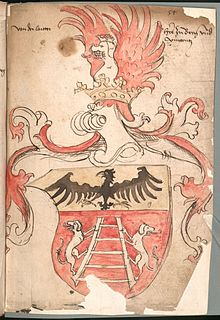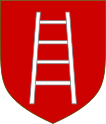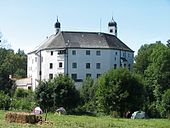Scaliger
The Scaliger ( Scaligeri , della Scala , German often also Scaliger , historically also lords of the ladder ) were lords of Verona from 1260 to 1387. In terms of cultural history, they play a role as builders of the Scaliger castles in northern Italy.
Family history
The family was of urban origin. The first to be known are an Adam as judge and a Baldwin as consul of Verona. Whether the Scaligeri were nobles is disputed; An origin from the merchant class was also assumed, but cannot be proven. Even before the death of Ezzelino da Romano (autumn 1259), who was elected Podestà by the city of Verona in 1226 and who had succeeded in converting the temporary office into permanent rule, the city council elected his supporter in January 1259 Mastino I della Scala zum Podestà del Popolo, who was successful with his attempt to make the signoria hereditary within his family: he initially ruled on behalf of the city, but then, when he was refused re-election in 1262, left himself after a coup the Capitano del Popolo appoint at the head of the troops. His main task was to organize the struggle of the city, which was actually ruled by the guild leaders, against the Guelphs , and he used the military task as a basis for the seizure of power by his family.
In 1277 Mastino was killed by a noble faction, but this did not affect the rule of the family. The subsequent government of his brother Alberto I della Scala as Capitano (1277–1301 - he was already Podestà of Mantua ) - was an uninterrupted war against the Counts of San Bonifacio, who were supported by the House of Este . His three sons Bartolomeo I della Scala (1301-1304), Alboino I della Scala (1304-1311) and Cangrande I della Scala (co-regent since 1308, 1311-1329 - Cangrande, the "big dog", was actually called Francesco ) successively inherited the office of Podestà. Alboino and Cangrande were jointly appointed Imperial Vicar of Verona in March 1311.
The youngest of the three brothers, Cangrande, shared the government with Alberto II della Scala (1311-1352), son of Alboino, after the death of his brother , and made a name for himself as a soldier, prince and patron saint of Dante , Petrarch and Giotto . By war or contract he brought the cities of Belluno , Bassano , Feltre , Padua (1328), Treviso (1308) and Vicenza under his control. In 1318 he was elected captain general by the Lombard Ghibelline League.
Alberto II and his younger brother Mastino II , who was his co-regent (1329–1351), were the richest and most powerful princes of their generation in Italy. The two continued the politics of their uncle (with Alberto in the background and Mastino left the politically active part), conquered Brescia in 1332 and extended their power beyond the Po . They acquired Parma (1335) and Lucca (1339) and provoked the fact that in 1337 a powerful coalition was formed against them: Florence , Venice , the Visconti , the Este and the Gonzaga allied, and after three years of war the Scaliger dominated again limited to Verona and Vicenza.
Mastinos son and successor Cangrande II. Della Scala (1351-1359) was a cruel and suspicious tyrant who tried to distance himself from his own subjects and surrounded himself with German mercenaries. He was killed in 1359 by his brother Cansignorio della Scala (1359-1375), who founded the state treasury, embellished the city with palaces and equipped it with bridges and aqueducts. When he murdered his second brother, Paolo Alboino (or Alboino II. Della Scala , who followed as Podestà in 1359 and resigned in 1365) in 1375 , he himself came to an end a few days later.
Fratricide was now just as common among the Scaligeri as double reigns. When Antonio (1375-1387), Cansignorio's illegitimate son, slew his brother Bartolomeo II (1375-1381) in 1381 (both were their father's successors), the people revolted and no longer stood behind him, as Gian Galeazzo Visconti of Milan declared war on him. When his resources were exhausted, Antonio fled Verona at night (October 19, 1387), which ended the rule of the Scaligans. He died the following year.
His son Canfrancesco tried unsuccessfully to recapture Verona (1390). Guglielmo (1404), illegitimate son of Cangrande II, was happier; with the support of the population, he drove the Milanese out, but died ten days later, whereupon Verona submitted to Venice (1405). The last representative of the Scaliger lived at the imperial court and tried repeatedly to get Verona back with the help of popular uprisings.
Two other scaligers later made a name for themselves as humanists :
- Julius Caesar Scaliger (Giulio Cesare Scaliger), who claimed to be the grandson of a son (Niccolò) of Guglielmo,
- and his son Joseph Justus Scaliger , who died in 1607 as a professor at the University of Leiden .
The Scaliger tombs in Verona
The Scaliger of Verona had their burial place at the Romanesque church of Santa Maria Antica in Verona, where their sarcophagi are in large tombs in the form of Gothic shrines with equestrian statues. The oldest grave is that of Mastino I from 1277, a wall niche grave. The grave of Cangrande della Scala from 1329 is located in a wall niche above a side portal of the church, on the top of the monument the prince is depicted as an equestrian statue. The other graves consist of sarcophagi, mostly made of stone, which are mostly in large tombs ( arche ) in the form of Gothic shrines ( tempietti ), which are supplemented with equestrian statues. They are not connected to the church, but are located next to it in a fenced area. The tomb of Mastino II is a tabernacle , that of Cansignorio is a marble monument built by Bonino da Campione (1375/76). The Scaliger graves were a popular motif of 19th century painters; see, for example, Eduard Gerhardt .
Own architectural style
The Scaligers are known to have their castles adorned with a special form of battlements . This is called the dovetail pinnacle because of its shape .
coat of arms
The talking coat of arms shows a silver ladder in red (Italian: Scala). Later she was accompanied by two dogs .
List of Podestà of Verona
- Lonardino (Mastino I) della Scala 1259-1277
- Alberto I della Scala 1277-1301
- Bartolomeo I della Scala 1301-1304
- Alboino I. della Scala 1304-1311
- Alberto II della Scala 1311-1352
- Francesco (Cangrande I) della Scala 1311-1329
- Mastino II. Della Scala 1329-1351
- Cangrande II. Della Scala 1351-1359
- Alboino II. Della Scala 1359-1365
- Cansignorio della Scala 1365-1375
- Bartolomeo II della Scala 1375-1381
- Antonio della Scala 1381-1387
Family relationships
- Jacopino della Scala († after 1248)
- Lonardino ( Mastino I. ) della Scala († 1277) Podestà of Verona 1259–1277
-
Alberto I della Scala († 1301) Podestà from Mantua, 1277–1301 from Verona
- 1. Bartolomeo I. della Scala († March 7 or 8, 1304) Podestà of Verona 1301–1304, ⚭ September 30, 1291 Costanza detta Antiochetta, daughter of Corrado de Antiochia ( Staufer )
- Ceccino della Scala († 1325)
- 2. Alboino I. della Scala († 1311) Podestà of Verona 1304–1311
- Alberto II. Della Scala (* 1306; † 1352) Podestà of Verona 1311-1352
-
Mastino II. Della Scala (* 1308; † 1351) Podestà of Verona 1329–1351
-
Cangrande II. Della Scala (* 1332; † 1359) Podestà of Verona 1351–1359
- Guglielmo della Scala († 1404)
- Alboino II. Della Scala (* 1344; † 1375) Podestà of Verona 1359-1365
-
Cansignorio della Scala (* around 1334; † 1375) Podestà of Verona 1365-1375
- Bartolomeo II. Della Scala († 1381) Podestà of Verona 1375–1381
- Antonio della Scala (* 1362; † 1388) Podestà of Verona 1381–1387
- Canfrancesco della Scala († after 1392)
-
Cangrande II. Della Scala (* 1332; † 1359) Podestà of Verona 1351–1359
- 3. Francesco ( Cangrande I. ) della Scala (* 1291; † July 22, 1329 in Treviso ) Podestà of Verona 1311–1329, ⚭ 1308 Giovanna († December 29, 1351 in Verona), daughter of Corrado de Antiochia ( Staufer )
- 4.? Federico della Scala, Lord of Valpolicella († probably 1349), ⚭ Imperatrice, daughter of Corrado de Antiochia ( Staufer )
- 1. Bartolomeo I. della Scala († March 7 or 8, 1304) Podestà of Verona 1301–1304, ⚭ September 30, 1291 Costanza detta Antiochetta, daughter of Corrado de Antiochia ( Staufer )
German line

History of the Scaliger in Bavaria
After Guglielmos I († 1404) was expelled, his widow and children found refuge at the court of the German Emperor Sigismund von Luxemburg . The family subsequently lived in Bavaria under the name of Herren von der Leiter ( von der Laitter or Leyter ) and their members held high offices there. In 1462 Johann von der Leyter led Lower Bavarian troops (against Albrecht Achilles of Brandenburg) and was knighted by Duke Ludwig the Rich after the battle . In 1475 Johann von der Leiter and his wife Helena von Closen took part as guests of honor at the Landshut princely wedding . In 1479, at the funeral of Ludwig the Rich, Johann was allowed to place the helmet and the jewels of the deceased duke on the high altar as one of three knights, the only one named. In 1500 the later Emperor Maximilian I confirmed the general vicariate of the cities and lands of Verona and Vicenza to the brothers Hans (Johannes). The king, some electors and princes of the empire sent letters to the Doge of Venice to confirm the legitimacy of the claim, but after a few exchanges of letters and heralds, it all petered out. Also on April 2, 1522 the gentlemen were confirmed by the leader of their vicariate for Verona and Vicenza at the Reichstag in Nuremberg (without consequences).
In the course of the Landshut War of Succession in 1504/1505, the Lords of the Ladder sided with the coalition of Duke Albrecht V and Emperor Maximilian. The damage they suffered in the war was compensated for in 1508 with the rule of Wald an der Altz . Johann the Elder was also appointed one of the guardians of the three underage sons of Duke Albrecht V. The last and heir daughter of the Scaliger in Bavaria was Johanna († 1654/55), who u. a. was married to Georg Sigismund Freiherr von Lamberg . The inheritance of the Herren von der Leiter in Bavaria went to this family.
Master list of the gentlemen from the ladder in Bavaria
NN
- Guglielmo, 1356 Canon of Verona, 1359 Canon of Vicenza, 1392 citizen of Venice, 1401/02 Podesta of Padua, 1404 Lord of Verona, † April 18, 1404, ⚭ NN, 1396 in Germany, † after 1410
- Brunoro, Dr. 1402, 1404 Ritter, 1404 (HRR) Lord of Verona, imprisoned May 1, 1404 (until 1406), January 2, 1412 vicar for Verona and Vicenza, † November 21, 1437, Vienna (buried in the Augustinian Church)
- Antonio, 1404 knight, 1404 lord of Verona, imprisoned May 18, 1404 (until 1406), † after 1412
- Nicodemo, January 7, 1441 ( HRR ) Vicar for Verona and Vicenza, 1419 Canon of Basel, 1420 Elect , 1423–1443 Bishop of Freising , † August 14, 1443 in Vienna
- Fergnano, May 20, 1438 Bavarian court master, 1418 (HRR) vicar for Verona and Vicenza, † December 4, 1443, ⚭ Viviana Visconti , † September 4, 1456, Milan
- Bartolomeo, 1418 imperial councilor, † March 21, 1433 in Vienna, ⚭ Anglesia, daughter of Duke Friedrich von Teck
- Oria (Laura), 1418, † 1451 in Vienna, 1. ⚭ before January 11, 1434 Hadmar V. Herr zu Laber , † January 11 (or June) 1434, 2. ⚭ Albrecht Graf von Brätt (Breta), † 1452
- Caterina, † March 3, 1423 in Vienna
- Paolo (Paulus) May 20, 1438 (HRR) Vicar for Verona and Vicenza, 1425–1429 Bavarian court master, † January 7, 1441, 1. ⚭ before 1433, Amalia von Fraunberg , 1448 nurse from Kelheim (then married twice)
- Lucia, 1451
- Beatrix, † February 14, 1486, ⚭ Munich, August 5, 1447, Wilhelm Graf zu Oettingen in Flochberg, † March 12, 1467
- Christiana, around 1450, ⚭ Eustach Landsiedler
- Johann von der Leiter, Lord of Bern and Vicenza, 1462 Knight, January 7, 1441 (HRR) Vicar for Verona and Vicenza, 1479 Bavarian Council, 1490 Vice Cathedral for Lower Bavaria, † November 20, 1490, buried in the Old Chapel in Regensburg, ⚭ 1475 Helene von Closen
-
Hans (Johann) the Younger, * 1470/71, 1508 in Wald an der Alz , 1514 Bavarian councilor, 1517–1547 governor of Ingolstadt, 1541 court master, † September 19, 1547 in Ingolstadt, buried in the Franciscan church
 Wald an der Alz Castle , Upper Bavaria (1721)
Wald an der Alz Castle , Upper Bavaria (1721) - Margareta, † December 25, 1520, ⚭ Wolfgang von Puchberg zu Winzer, captain zu Burghausen, † September 8, 1522
- Magdalena, ⚭ Johann von Zelking , † after 1498
- Anna, ⚭ Hans von Mätschalch
- Hans (Johann) the Elder, 1508 in Wald an der Alz , 1500 Bavarian councilor and vicarage in Lower Bavaria, Landhofmeister in Munich, 1516/1523 caretaker in Schärding and Julbach, † September 19, 1541, ⚭ Margareta von Laimingen , daughter of Christoph zu Amerang and Benigna von Fraunberg, when Margaretha married Johann in 1497, Amerang Castle came to the Scaliger family in 1542
-
Hans Bruno, died on April 14, 1544 in Ceresòle d'AlbaAmerang Castle , Upper Bavaria
- Anna, † after 1545, buried in Gaildorf , ⚭ 1530 in Augsburg, Wilhelm Schenk von Limpurg zu Gaildorf, † March 9, 1552
- Maria, ⚭ 1556, Michael Freiherr von Swihowsky von Riesenburg, nurse zu Nellenburg , † 1577
- Veronika, 1574 nun in Frauenchiemsee Abbey
- Hans Christoph, enrolled in Ingolstadt in 1524, nurse von Schärding in 1542/43, died on April 14, 1544 in Ceresole , ⚭ Elisabeth von Zollern , daughter of Count Franz Wolfgang and Rosina, Margravine of Baden, † in Amerang July 3, 1573
- Wilhelm, enrolled in Ingolstadt in 1552/57, Bavarian councilor in Eisolzried, 1569/1574 nurse in Wemding , 1570/80 nurse in Wasserburg, † in Wasserburg June 14, 1580
- Hans Warmund, enrolled in Ingolstadt in 1556, in Amerang, 1580/81 nurse in Wasserburg, † in Amerang May 24, 1592, ⚭ May 21, 1570 with Elisabeth von Thurn-Valsassina , † in Amerang January 29, 1579
- Hans Dietrich zu Amerang, Eisolzried and Wald an der Alz, Bavarian Regency Council in Landshut , born June 25, 1571, † in Neufraunhofen October 25, 1598, buried at Amerang
- Johann Christoph, born September 27, 1572, † October 22, 1572
- Johanna, heiress of Amerang Castle , * May 2, 1574, † in Tittmoning 1654/55, ⚭ before May 18, 1600 Count Sigismund von Dietrichstein , Baron von Hollenburg, Finkenstein and Thalberg, † 1605, † in Kremsier 25 November 1607 Georg Sigismund Freiherr von Lamberg , 1605/07 governor of the state above the Enns , † in Kitzbühel May 5, 1632
- Elisabeth, * May 21, 1575, † July 8, 1575
- Anna Maria, * July 16, 1576, ⚭ Karl Freiherr Villinger zu Schönberg, Herr zu Seyfriedsberg, 1516 carer at Wemding, † after 1617
-
-
Other famous people
- Nicodemus della Scala († 1443), Prince-Bishop of Freising (1422–1443)
- Julius Caesar Scaliger (* 1484; † 1558), Italian humanist, poet and naturalist
- Joseph Justus Scaliger (* 1540; † 1609), son of Julius Caesar Scaliger. The Huguenot is considered to be one of the greatest scholars of the second half of the 16th century. In several of his writings he tried to get a more correct understanding of ancient chronology.
See also
Individual evidence
- ↑ Schloss Amerang: History
- ^ Giulio Sancassani: Note genealogiche degli scaligeri di Verona: le origini (1147-1277). In: Verona e il suo territorio. Volume 3: Verona scaligera. Part 1. Istituto per gli Studi Storici Veronesi, Verona 1975, pp. 311-343.
- ↑ Andrea Castagnetti: Comments on a History of Society and Politics of the Cities in the Mark Verona-Treviso (11th – 14th centuries). In: Reinhard Elze, Gina Fasoli (ed.): City nobility and bourgeoisie in the Italian and German cities of the late Middle Ages (= writings of the Italian-German Historical Institute in Trient. Vol. 2). Duncker and Humblot, Berlin 1991, ISBN 3-428-07009-7 , p. 31-57, here p. 46 f.
- ↑ u. a. after The Lords VON DER LEYTER (Skaliger) in Bavaria from 1400–1511
- ↑ Master list based on Detlev Schwennike (Ed.): Europäische Stammtafeln . Family tables on the history of the European states. New episode, Volume 16: Bavaria and Franconia. JA Stargardt, Marburg 1995, ISBN 3-465-02741-8 , plate 4, p. 4.











